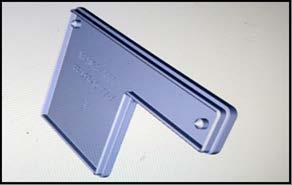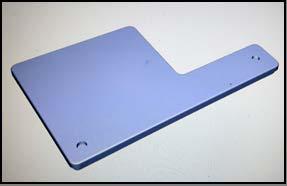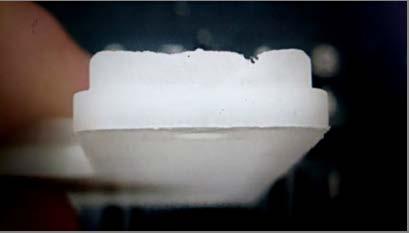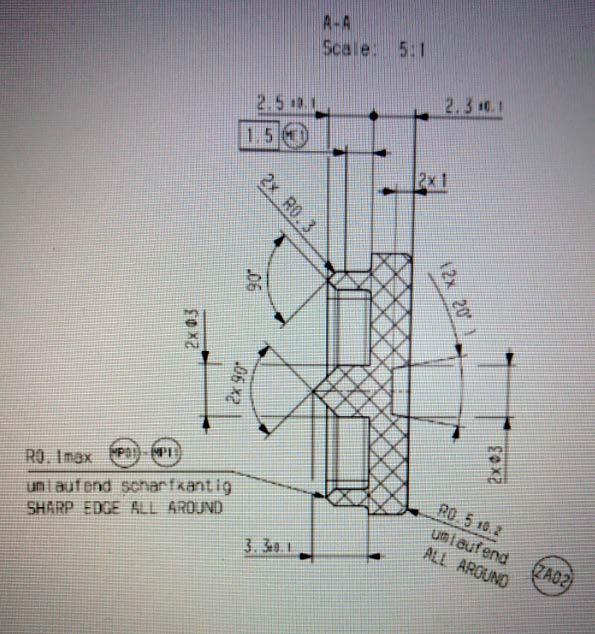
13 minute read
Kangalov, Mitko Nikolov, Pavol Findura, Petr Bartos, Olga Urbanovicova
from Agricultural, Forest and Transport Machinery and Technologies (ISSN: 2367– 5888) vol VII, 2020
by kangalov
Standardization of Cooperation between Production and Supply Quality in Production Organization
Miroslav Pristavka, Hristo Beloev, Plamen Kangalov, Mitko Nikolov, Pavol Findura, Petr Bartos, Olga Urbanovicova
Advertisement
Abstract: Standardization of processes is currently an essential part of manufacturing organizations. It is a very effective way to increase efficiency in achieving the desired goals, making organizations more competitive. However, it is important that processes are standardized at all levels without exception. It is enough that a few processes do not have clearly defined duties and responsibilities and the performance of the whole system is noticeably reduced. The standardization of the cooperation process between production and supplier quality departments was carried out in an unnamed organization. The basic activity in which these two departments worked together was to solve the problems with the supplied material. Production quality gave impulse from production about the problem with the supplied material and the supplier quality solved this problem by issuing a complaint to the supplier. However, this process often led to inadequate analysis, loss or misunderstanding of the information, or to the issuing of complaints with considerable delay. These problems stemmed from insufficiently defined responsibilities and from a non-standardized process of cooperation between these departments. The aim of the article was to define responsibilities for both departments, to create a flow chart for the procedure for managing nonconforming input material and to create a form for submitting the information needed for opening of claim to the supplier. Subsequently, the proposed methods were applied to a specific complaint, which confirmed, that thanks to standardization, the process of opening and resolving supplier complaints was significantly streamlined and the cooperation between these two departments was significantly improved. Keywords: organization, production quality, standardization
INTRODUCTION
Standardization as a process is a very effective tool to reach sustainability, prosperity and competitiveness. Its basic advantage is that it clearly defines the borders, responsibilities and competencies. If we manage an organization and have no standards, procedures and documents, based on which we could clearly determine who and how to do things, we cannot speak of organized management (Bujna et al., 2019, Korenko et al., 2015).
One of the basic aspects of each organization is a quality. Quality in an organization does not only include visibly reliable products and their properties. There is also a large number of processes that control and influence quality. Thus, these processes can directly influence finished products, their compliance with customer requirements and it is therefore necessary to manage these processes. Standardization in this case is crucial because it has a significant impact on the future of an organization [Bujna-Kielbasa, 2019, Lilko et al., 2019).
MATERIALS AND METHODS
The main objective of the paper was to standardize cooperation between departments of production and supply quality. To fulfil the objective, it was necessary to create a form, which was a basis of creation and solution of a claim against supplier. The created standard, including responsibilities and procedures together with a form to transfer information, was applied to the issue and we confirmed whether cooperation between departments is more effective (Bujna et al., 2015).
We monitored two objects, department of supply quality, responsible for input material in the processes and department of production quality, serving for providing information about problems with the material. Both departments worked on the common objective, that is ensuring smooth running of production with an input material without different variations.
Standardization process: selection of a workplace, analysis of the current state of realization and conditions of process on a workplace, proposal and implementation of rationalized measures, creation of working standard (Cvíčela, 2020).
Form for information necessary to create supply claim
The form (Table 1) was established based on needs of department of supply quality. This form included all the necessary information, which an employee of supply quality needs, to be able to provide a claim for supplier (Cvíčela, 2020). Table 1 A sample form for information necessary to open a supply claim:
FORM FOR INFORMATION NECESSARY TO OPEN SUPPLY CLAIM
Number of material + index: Supplier: When did the problem occur for the first time?
xxxxxx-xxx Name of supplier Date, time, shift
Who identified the problem? Quality engineer, operator, controller on the line Where was the problem identified? Before/ after process on the line, control at the end of line, audit
How many mismatched pieces were found and produced?
Raw material: amount
Unfinished production: amount
Finished products: amount
Suspicious material: amount
Trend: Description of a problem:
Random, specific side, cavity Brief results of internal analysis What causes it? Consequence of the deviation Immediate reaction on the line: Exchange of boxes Exchange of production charges Change of produced model Immediate reaction to ensure production: Classification on the line Classification by external company Replacement delivery Need to check stock
Analysed mismatched parts for supplier as a proof:
YES NO If yes, number: amount Form submission date: Date, time For the production of quality department: Name, Surname For department of supplier quality: Name, Surname
Appendix:
1) Supplier information tag Enclosed photo or a scan of a tag 2) Technical drawing/ documentation A clipping from a drawing that relates to a parameter that is out of specification 3) Results of measurement Results of measuring equipment/ protocol 4) Photo documentation of deviation In case of visible deviations e.g. sprays, underwear, visible mechanical damages
RESULTS Application of established procedures within solution of a specific claim
In production organizations, into which a large amount of materials enters, we often find their deviations. No process is perfect, thus there are deviations from specification on the
input materials time to time. Effort to solve these deviations and minimize their amount is directly proportional to supplier quality. Some suppliers have better run processes, some do not, but in general it is always inevitable to solve the problem so that it does not repeat and that the corrective action is effective and lasting. This is ensured by 8D methodology (Fig. 1), which is processed by the supplier who happened to have the problem. The whole process of problem solution is under control of department of supplier quality (Cvíčela, 2020).
Characteristics of a supplier
A supplier is primarily specialist to metal forming (pressing, shaping, fine cutting), hybrid plastic injection, assembly of sets, it also focuses on other production technologies. It produces highly quality components and sets for customers especially from the area of automobile industry, they also supply telecommunications, home appliances and lighting. Among specific products there are for example: locking systems, fastening and hinge systems, suspension and damping systems, or exhaust and propulsion systems.
Characteristics of a supplied part
The electronics cover (Fig. 2) is a component, which is created by a process of plastic injection. Basic functions of plastic cover are: protection of electronics of finished product against mechanic damage, closure of functional space of finished product and protecting it against pollution, ensuring tightness of finished product.
Internal analysis in the process
Finished products are in final stage of production subjected to several types of tests. One of various characteristics which must be fulfilled by our product according to
Impuls from production to department of supplier quality Opening claim on supplier Acceptance of a claim and solution of problem by 8D methodology
8D report sent for approval until accepted – consequently the claim can be closed
Fig. 1 Scheme of information flow within solution of problem on a supplied component
Fig. 2 3D model of electronics cover

specification, is to tightness.
During testing at the end of production line, we came across a problem with insufficient tightness. The parts are tested for tightness, so that pressure is introduced into them through a special membrane and it is monitored for a certain time whether it decreases. In our case we noticed a decrease of pressure.
We selected 10 mismatching parts which were discarded by the line and we analysed them. To determine leaking, we used a simple test – finished product was put in a box with water. From the edge of the electronics cover we noticed air leaking. Next step was to uninstall the cover from the product. After disassembly we found imperfectly injected (damaged) edge of the cover which caused leaking (Fig. 3). To eliminate the impact of the process, we controlled the raw pieces in packaging, which did not enter the production line. After random control of some pieces, we found a similar error on raw parts, based on which we concluded that the problem is on the supplier´s side.

Fig. 3 Imperfectly injected edge of the electronics cover
To ensure production, we withdrew a new packaging from the stocks with new production charge. However, the problem did not disappear with the new packaging and the covers with an imperfect edge were also there. Therefore, it was necessary to start internal classification on the line, to minimize number of mismatching finished products.
Table 2 Fulfilment of the form for submission of the necessary information to open a claim against the supplier
FORM FOR INFORMATION NECESSARY FOR OPENING SUPPLIER CLAIM
Number of materials + index: A64078-114
Supplier: When did the problem occur for the first time?
12.6.2020 Who identified the problem? Line controller Where was the problem identified? At the station of the final control in production line
How many mismatching pieces were found and produced?
Raw material: 8 pcs.
Unfinished production: 0 pcs.
Finished products: 30 pcs.
Suspicious material: 28 800 pcs.
Trend: Random Description of a problem: Missing material on the edge of electronics cover What causes it? Imperfection in tightness of finished product Immediate reaction on the line: Exchange of boxes Exchange of production charges Change of produced model
Immediate reaction to ensure production:
Classification on the line Classification by external company Replacement supply Need to check stock
Analysed mismatching parts for a supplier as a proof:
YES If yes, number: 5 pcs. Date of submission of the form: 26.6. 2020
For the department of production quality: For the department of supplier quality: Appendix: 1) Supplier information tag 2) Technical drawing/ documentation
NO

3) Results of measurements It is not necessary to give results of measurement, as deviation is unquestionable.
4) Photo documentation of deviation

Due to standardization of processes and cooperation between departments of supplier and production quality, there has been a significant improvement and streamlining of the solution of claims to the supplier. This streamlining was encouraged by defining of responsibilities of individual departments, creation of development diagram for the procedure of managing non-conforming input material and creating a form for submitting data to open a claim to the supplier. These individual steps were successfully applied to a specific complaint, which resulted in a prompt analysis of the problem and its flexible transfer to the supplier, who could respond in the shortest possible time by sending a replacement delivery and solving the problem in its essence. Thanks to this, the production could run without problems and the customer´s orders could be reliably delivered.
The form (Table 2) for submitting the necessary information to open a claim against the supplier is used mainly in organizations to which material from external suppliers enters. It is an effective tool for quick summarizing of inevitable information and actions to solve a problem with a supplied material (Cvíčela, 2020).
CONCLUSION
Standardization as a part of production organizations has its significance. Its basic impact on organization reflects especially in effectiveness of processes, which directly results in higher competitiveness and prosperity of organizations. The objective was to standardize process of cooperation between departments of production and supplier quality in favour of streamlining the solution of non-conforming input material. Defining individual duties solved a question of „who should do and what? “. Thanks to clearly defined responsibilities on both parties, there have been cases where the problem has remained with both parties waiting for the other to take a step. Creation of the form for effective submission of information supported speed of response and ensured that the necessary data were collected and transmitted at once.
All the steps of standardization led to a common goal – to ensure smooth running of production with material which fulfils requirements of specification. As a result, the organization can work with higher efficiency and higher assurance that the material from which they produce, is in the required condition and fulfils all the criteria to ultimately meet the customer´s needs with the utmost satisfaction.
REFERENCE
[1] Bujna, M., Beloev, H., (2015) Tools of risk management in production processes. 1st ed., Ruse : Angel Kanchev University of Ruse, 2015. pp. 105. ISBN 978-954-712-654-1. [2] Bujna, M., Kangalov, P., Nikolov, M., (2019) The influence of the depositio rate of application on the thickness of the molybdenum layer. In Agricultural, forest and transport machinery and technologies. Rousse: Angel Kanchev University of Rousse, 2019, p. 38--43. [3] Bujna, M., Kielbasa, P., (2019) Objectification of FMEA method parameters and their implementation on production engineering. In Trends in agricultural engineering. Praha:
Česká zemědělská univerzita, 2019, p. 75--80. ISBN 978-80-213-2953-9. [4] Bujna, M., Kotus, M., Matušeková, E., (2019) Using the DEMATEL model for the
FMEA risk analysis. In System Safety: Human - Technical Facility - Environment. 1, 1 (2019), p. 550--557. ISSN 2657-5450. [5] Cvíčela, M., (2020) Standardization of cooperation between production and supplier quality in a manufacturing organization. [Diploma thesis], Nitra, 2020. [6] Gáher, F. - Marko, V., (2017) Method, problem and task. Publisher UK, Bratislava, p. 44.
ISBN 978-80-223-4242-1.
[7] Hrubec, J. - Cservenáková, J., (2016) Engineering of quality production. Publisher SUA,
Nitra. ISBN 978-80-552-1536-5. [8] Hučka, M., (2017) Models of company processes. C.H. Beck, Praha, p. 512. ISBN 97880-7400-468-1. [9] Korenko, M., Prístavka, M., Drlička, R., (2015) Management of quality processes.
Publisher SUA, Nitra. ISBN 978-80-552-1316-3. [10]Lilko, J., Kotus, M., Dobiaš, P., Ponjican, O., (2019) Hardfacing electrodes resistance in laboratory conditions. In Trends in agricultural engineering. Praha: Česká zemědělská univerzita, 2019, s. 337--340. ISBN 978-80-213-2953-9. [11]Mateides, A., (2006) Management of quality. ISBN 80-8057-656-4, [12]Paulová, I., (2009) Approaches to quality management in educational organization/schools. Methodological- pedagogical centre, Bratislava, ISBN 978-808052-346-6. [13]Paulová, I., (2013) Complex quality management. Iura Edition,Ltd., Bratislava. ISBN 978-80-8078-574-1. [14]STN EN ISO 9000: 2016. Quality management system. Basics and vocabulary. [15]STN EN ISO 9001: 2016. Quality management system. Requirements. [16]STN EN ISO 9004: 2010. Management of the organization´s lasting success. Approach based on quality management. [17]Závadský, J., (2004) Process management in managerial practice. SP Synergia, Trnava.
ISBN 80-968734-8-2.
CONTACTS
Miroslav Prístavka, Department of Quality and Engineering technologies, Faculty of Engineering, Slovak University of Agriculture in Nitra, Tr. A. Hlinku 2, 949 76 Nitra, Slovakia, e-mail: miroslav.pristavka@uniag.sk
Hristo Beloev, Department of Agricultural Machinery, Agrarian and Industrial Faculty, University of Ruse, 8, Studentska Str., 7017 Ruse, Bulgaria e-mail: hbeloev@uni-ruse.bg
Plamen Kangalov, Department of Repair and Reliability, Agrarian and Industrial Faculty, University of Ruse, 8, Studentska Str., 7017 Ruse, Bulgaria, e-mail: kangalov@uni-ruse.bg
Mitko Nikolov, Department of Repair and Reliability, Agrarian and Industrial Faculty, University of Ruse, 8, Studentska Str., 7017 Ruse, Bulgaria, e-mail: mnikolov@uni-ruse.bg
Pavol Findura, Department of Machines and Production Biosystems, Faculty of Engineering, Slovak University of Agriculture in Nitra, Tr. A. Hlinku 2, 949 76 Nitra, Slovakia, e-mail: pavol.findura@uniag.sk
Petr Bartoš, Department of Agricultural Machinery and Services, Faculty of Agriculture, University of South Bohemia in České Budějovice, Na sádkách 1780 370 05 České Budějovice, Czech Republic, e-mail: bartos@zf.jcu.cz
Oľga Urbanovičová, Department of Machines and Production Biosystems, Faculty of Engineering, Slovak University of Agriculture in Nitra, Tr. A. Hlinku 2, 949 76 Nitra, Slovakia, e-mail: olga.urbanovicova@uniag.sk









